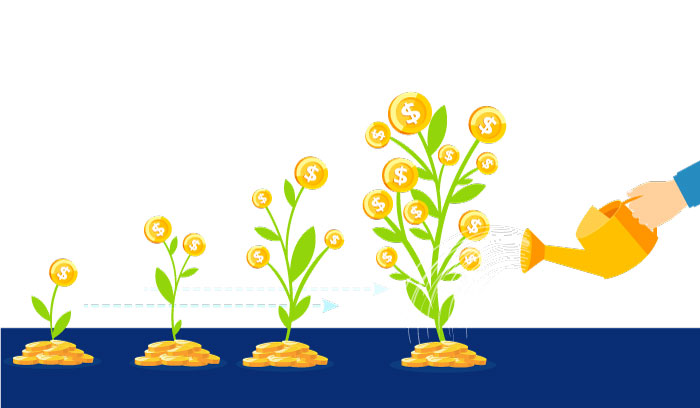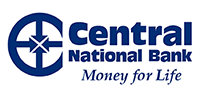
The FDIC recently published an article on their Consumer News blog about starting small to build savings. There are a number of strategies and options, but many Americans get discouraged about saving when they realize just how long it can take to build wealth, or they cannot decide the best way to go about building wealth. Today we’re going to follow the outline of the FDIC’s article and break it down for you by Central National Bank product and service, to cut out some of the noise and help you get on your way to saving.
Save for specific goals
The FDIC recommends setting up a savings plan for future expenses. How do you go about doing that? The easiest way we know of is to set some goals. Our MoneyCentral budgeting tool, available in our online banking platform and app, has a goal tracker. Log in to online banking or the app and navigate to the MoneyCentral tab. From there, navigate to Goals, or click on the “Add Goal” button on your dashboard. The tool will walk you through some options like “pay off credit card”, “save for college”, “save for vacation” and more. Once you select an option the app will walk you through setting an amount, selecting a completion date, and creating the tracking and notifications you need to stay on task.
It helps immensely if you have a Central National Bank savings account set up. Check out our website for more information about our accounts.
Commit to saving money regularly
The FDIC also recommends getting into the habit of saving regularly. Perhaps the hardest part of doing this is remembering to actually transfer the money you want to save over from checking to savings. It’s easy to set up automated transfers between accounts though, with our app.
To set up a reoccurring transfer simply click on the transfer option and then select the accounts you want to take the money from and deposit the money into. Then, select an amount. Click on “More Options” to set up a frequency. I was able to set up a monthly transfer using this tool and was able to start it on my next payday. Setting up an automatic transfer for payday ensures that you won’t accidentally overdraw your account. If you get in a bind, you can always transfer the money back out of savings, but be careful to plan this out. You don’t want to get into a habit of transferring money back and forth. Many savings accounts have a minimum withdrawal limitation that could cost you extra.
Put your savings on autopilot
Now we’re ahead of ourselves because this tip is essentially the same tip we just gave! The FDIC recommends paying yourself first, so be sure to save money before paying for extras each month. It’s a good idea to budget for your savings so you don’t need to move money back and forth at the end of the month. Check out the personal finance category on our blog for ideas about saving and how you can set up a budget for yourself.
Make use of tax-advantaged retirement accounts and matching funds
The FDIC recommends saving for retirement sooner rather than later. If you’ve not started saving for retirement yet you can do so in a number of ways. The first recommendation we have is to participate in an employer-sponsored retirement plan. This might be a 401(k) or an IRA (Individual Retirement Account) plan. The FDIC mentions both of these options in a little more detail, and we have additional resources as well on this blog site.
The first thing to note about retirement plans is that they are not all created the same. Some investment accounts are riskier because they may not be insured by the FDIC even if the bank is insured by the FDIC. How does that make sense? Well, one example is when a bank operates a wealth management or trust services division under their corporate umbrella, but the products and services they offer are not FDIC insured.
Does it mean that your money isn’t safe there? Not necessarily! It just means you’re willing to accept a certain amount of risk by investing your dollars in stocks and bonds that aren’t secured. There’s a higher chance for greater returns, but you also have to be willing to risk some losses as well. There’s a wide range of options with different levels of risk. For instance, a 25-year-old preparing for retirement can afford to risk much more than a 55-year-old preparing for retirement. If the markets dip you have more time to recover any losses, the younger you are.
We do offer IRAs and CDs (Certificates of Deposit) as a savings option though, which are also considered “retirement” savings. Neither of these types of savings options require a meeting with an investments advisor if you don’t feel like you’re up to that yet. You can set up an automatic transfer to an IRA just as easily as a savings account. CDs are simple to set up if you have $5,000 to start one, and there is the advantage of earning interest on these types of savings methods.
Separating savings for certain purposes
The FDIC recommends keeping your savings in different accounts, other than checking. It’s a good idea to utilize different account types and savings options for different purposes. It’s okay to tie up retirement money in a CD or IRA if you’re not planning to retire anytime soon, but you wouldn’t want to keep your emergency savings money in that type of account because it would be harder to access in an emergency.
Think about ways to cut your expenses
We’ve covered this topic in a variety of ways over the years. Check out our blog for a roundup of ways to cut costs. The options are endless and contrary to popular belief, you may not need to scrape the bottom of the barrel in order to save. Starting out small is the key!
If you need additional information on saving money, check out the FDIC’s Consumer News blog, or our own blog’s archive. Don’t forget to check with your local banker who might also have recommendations for specific account types you should consider.
